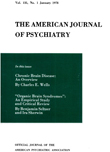INFERENCE TESTING IN PSYCHOTHERAPY
Abstract
"Psychotherapy" may be defined as the use of psychological means to mitigate symptoms, to resolve conflicts, and to improve generally the patient's adjustment. In doing psychotherapy, the doctor makes inferences from both the verbal and nonverbal behavior of the patient. These inferences help the doctor to understand the patient and are used for purposes of interpretation. It is necessary to establish the validity of these inferences in order to make reliable predictions or to institute rational therapy.
All this, we realize, is easier said than done. But if we are going to be able to do it as well as possible, in spite of the limitations imposed by the nature of the material, we must formulate our inferences in words that are clear and unambiguous so that the statements in which they occur will be intelligible. Furthermore, if these statements are going to be not only intelligible but technically verifiable, we must be able to get at, and to identify, the facts inferred. When and only when these two logical conditions are fulfilled, are we in a position rigorously to establish the existence of causal laws of human behavior.
But we must admit that these statements express a scientific ideal that can be approached but hardly attained in the field of psychotherapy. Ideally, to be sure, inferences should be so formulated that they can be decisively verified (or disverified) by reference to public, reproducible facts, which can be precisely measured. But in view of the private status and inherent obscurity of some of the relevant data, we cannot, in the field of psychotherapy, achieve such logical perfection, but must be guided by the greater weight of evidence and be satisfied with a degree of confirmation that is pragmatically sufficient. However, without being neurotically perfectionistic about it, we may reasonably strive to increase the reliability of our inferences in this field. To do this, we must first define our terms, we must second verify the claim that referents for these terms exist, and we must third show that these referents stand in the empirical relations claimed. Only in this way can we know, with a sufficient degree of clarity, what things we are talking about, and how these things are related in nature—which is the kind of knowledge that, in its applications, gives us increased power to help our patients.
Access content
To read the fulltext, please use one of the options below to sign in or purchase access.- Personal login
- Institutional Login
- Sign in via OpenAthens
- Register for access
-
Please login/register if you wish to pair your device and check access availability.
Not a subscriber?
PsychiatryOnline subscription options offer access to the DSM-5 library, books, journals, CME, and patient resources. This all-in-one virtual library provides psychiatrists and mental health professionals with key resources for diagnosis, treatment, research, and professional development.
Need more help? PsychiatryOnline Customer Service may be reached by emailing [email protected] or by calling 800-368-5777 (in the U.S.) or 703-907-7322 (outside the U.S.).



